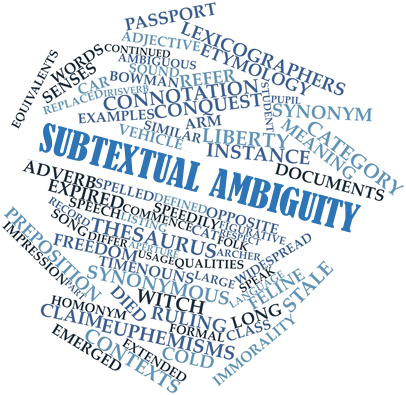14 Jul Understanding Subtext
 If human interaction were simple and straightforward, computers would have been able to do a credible job of imitating it years ago. Examples of simple interaction machines, including the Rogerian Psycho-therapist named Eliza and the question answerer named Watson, show that computer algorithms can do pretty well at some interaction tasks. If all human interactions were perfectly logical, truthful, and without poetry or innuendo, the task of understanding what humans say would be much easier. But my attempt is not to understand everything anyone says – just to approximate human competence in understanding spoken and written language. An important aspect of context is that huge amounts of unspoken references to shared experience shape the way we say things and the way those utterances are meant to be understood.
If human interaction were simple and straightforward, computers would have been able to do a credible job of imitating it years ago. Examples of simple interaction machines, including the Rogerian Psycho-therapist named Eliza and the question answerer named Watson, show that computer algorithms can do pretty well at some interaction tasks. If all human interactions were perfectly logical, truthful, and without poetry or innuendo, the task of understanding what humans say would be much easier. But my attempt is not to understand everything anyone says – just to approximate human competence in understanding spoken and written language. An important aspect of context is that huge amounts of unspoken references to shared experience shape the way we say things and the way those utterances are meant to be understood.
Ambiguity has many forms, some of which are in the syntax and morphology of words, phrases and sentences. Resolving that ambiguity is necessary for humans and computers to achieve full understanding. Understanding things that are not contained in the words, phrases and sentences is much more difficult for computers.
| Understanding Context Cross-Reference |
|---|
| Click on these Links to other posts and glossary/bibliography references |
|
|
|
| Prior Post | Next Post |
| Motor Center Structure | Democratization of Knowledge |
| Definitions | References |
| logical form subtext | Wikipedia's opening on subtext |
| meaning context | Language Surfer Eliza |
| intent algorithm | Watson |
Meaning under the Surface
 Part of the problem lies in the subtext. Culture, gender, economic stratum, time of day, geography and other contextual factors interfere with simple meaning. Let’s start with gender: no matter how well a person controls her or his thoughts, the fact of gender is omni-present in cross-gender dialog. This is true in societies where strictures control how women dress in public, and societies that are much more liberal in interpreting gender roles. Gender-related subtext may never leave the brain to be verbalized by the communicating parties, therefore have no impact on the way the words reflect intent. But drifting around in the neurons adjacent to intent is the subtext. And the most effective conversationalists can let the subtext surface at appropriate times in ways that are engaging, funny or seriously meaningful. I like Wikipedia’s opening on subtext: “Subtext or undertone is content of a book, play, musical work, film, video game, or television series which is not announced explicitly by the characters (or author) but is implicit or becomes something understood by the observer of the work as the production unfolds.” This applies, to art specifically, but is equally present in everyday communication as connotation, nuance, implication and subconscious context.
Part of the problem lies in the subtext. Culture, gender, economic stratum, time of day, geography and other contextual factors interfere with simple meaning. Let’s start with gender: no matter how well a person controls her or his thoughts, the fact of gender is omni-present in cross-gender dialog. This is true in societies where strictures control how women dress in public, and societies that are much more liberal in interpreting gender roles. Gender-related subtext may never leave the brain to be verbalized by the communicating parties, therefore have no impact on the way the words reflect intent. But drifting around in the neurons adjacent to intent is the subtext. And the most effective conversationalists can let the subtext surface at appropriate times in ways that are engaging, funny or seriously meaningful. I like Wikipedia’s opening on subtext: “Subtext or undertone is content of a book, play, musical work, film, video game, or television series which is not announced explicitly by the characters (or author) but is implicit or becomes something understood by the observer of the work as the production unfolds.” This applies, to art specifically, but is equally present in everyday communication as connotation, nuance, implication and subconscious context.
Wikipedia’s article goes on: “Subtext can also refer to the thoughts and motives of the characters which are only covered in an aside. Subtext can also be used to imply controversial subjects without specifically alienating people from the fiction, often through use of metaphor.” “Subtext is the undertone or content beneath spoken dialogue. The intent behind dialogue can include conflict, anger, competition, pride, showing off, or other implicit ideas and emotions. Subtext is the unspoken thoughts and motives of characters—what they really think and believe.” As I have shown in the first section on the brain, emotions and other less-than-perfectly-logical inputs are necessary for complex cognition, of which social interaction can be the most complex. For less effective communicators, the subtext can be vexing, and the times it surfaces can be damaging.
Dialog and Identity
In human communication, I suspect that the biggest element of subtext is identity. We self-identify based on how we invest our time, our hearts and our minds. I personally identify myself based on my gender, family, religion, profession and my favorite hobbies (in my case music, camping and water-sports). We cross-identify based on cultural norms. In more liberal societies, we impose less constraint on others’ identities, while more authoritarian  societies narrow the options. Another way of stating this, my suspicion, is that answers to three questions form the core of subtext:
societies narrow the options. Another way of stating this, my suspicion, is that answers to three questions form the core of subtext:
- How do I identify myself?
- How does my self-image color the way I identify others?
- How do others identify me?
These first three core elements of of subtext change with context. The two most persistent and universal elements of context are time and space. Where I am (space) changes the way I see myself and others. If I’m at home or abroad, in the campground or standing on risers set up for a choir, I see myself differently. The differences are in the priorities in which I organize the aspects of my identity and others’ identities. Time interacts with identity in a similar way. In the United States at the time of this post, we are in the midst of a polemical Presidential campaign season. During this time I am more likely to shift my political views to a higher position in my overall identity. The point of this post is that subtext serves as a sandy foundation upon which we build social interactions, affecting communication and cognition.
| Click below to look in each Understanding Context section |
|---|








